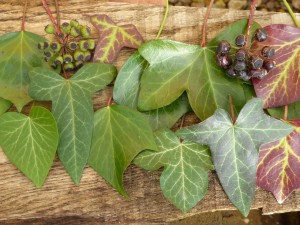At this time of year when deciduous trees and shrubs are only just beginning to bud, the glossy evergreen leaves of ivy and its tangle of climbing stems really stand out. Common ivy in fact provides a year-round place for a variety of creatures to hide, breed, feed and even hibernate. It is easy to recognise and is found growing almost everywhere – up trees and old walls, in hedges and carpeting woodland floors, and its value for wildlife makes it a great focus for investigations.
Ivy facts
- The very hungry caterpillar: The beautiful Holly Blue butterfly lays its eggs on ivy and the hatching caterpillars feed on the flower buds in August and September. It then hibernates as a chrysalis, emerging in April on a sunny day. Sixteen species of moth are also known to use ivy as caterpillar food.
- Refuelling station: Ivy flowers in late autumn between September and November, producing a mass of pom-pom like flowers that provide nectar and pollen for late-flying butterflies such as Red Admiral, Painted Lady, Small Tortoise Shell and Speckled Wood.
- Nectar: Many other pollinating insects will feed on its yellow-green flowers – wasps, hornets, honey bees and hover flies – filling up on the valuable nectar before hibernating. Listen to the humming of insects when the sun is out.
- Winter larder: After flowering, the green ivy berries turn black when ripe and are a good source of food for hungry birds in late winter. Look for ivy plants trembling as blackbirds, thrushes and pigeons pull the berries from their stems.
- Close up on leaves: There are two sorts of ivy leaves to find. Leaves with three or five pointed lobes – these are found growing on the climbing stems which use tiny roots to grip. Whilst leaves on the flowering and fruiting stems are heart shaped with no lobes – these grow spirally around the stem and reach towards the sun (aerial leaves.)
- Camouflage: Adult butterflies such as the pale yellow Brimstone, Peacock, Comma and both Large and Small Tortoiseshell hibernate within the protective cover of ivy.
Ivy activities
- Look for a variety of ivy leaves (both climbing and aerial) to create a collage of different shaped leaves, colours and vein patterns – you’ll be surprised by the diversity! Measure the length and width of each leaf to compare leaves. Which is the widest/narrowest?
- Cut a selection of ivy leaves in half. Most leaves will be naturally symmetrical – the left and right sides of a leaf will be the mirror image of each other. Place the leaf halves on paper and challenge group to draw the missing half. They can check by finding and matching the missing halves – how well do they match up with drawn image? Is any leaf perfectly symmetrical?
- Citizen science – record your first sighting of butterflies on the wing. This can lead into a discussion about butterfly life cycles, caterpillar food plants – first and second broods – and how best to garden for insects.
- Hide some model insects within some ivy to demonstrate how resting and hibernating insects use camouflage to hide. Can the group point out where all the insects are hidden? Collect back and discuss different camouflage strategies.
- Increase the wildlife value of walls and fences by allowing ivy to form an evergreen overcoat. Why not make some insect hotels and place these by establishing ivy to encourage insects to move in.
- Make an ivy trellis. Mount a trellis on wooden blocks to leave an 8-10cm gap between the back of trellis and the fence or wall. Once established the ivy will create a protective screen for nesting birds such as wrens, robins and dunnocks and also provide cover and shelter for insects and mammals.
Happy exploring!

